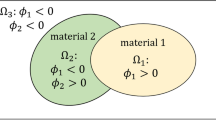Abstract
In this work, a meshless method based on the alternating active-phase algorithm is proposed for the multi-material topology optimization problems. Mathematic model of the proposed method is built by the solid isotropic microstructure with penalization (SIMP) theory and solved by the optimality criteria. During the optimization process, the nodal relative density is chosen as the design variable and Shepard interpolation combined with the moving least squares (MLS) shape function is utilized to obtain the nodal relative density. Nodal integration method is then adopted to obtain the structural stiffness matrix, with the purpose of promoting the computational efficiency. Since the element-free Galerkin (EFG) method is applied to analyze the structure, sensitivity filtering is avoided and mesh-dependence phenomena are alleviated. Several numerical examples are provided to illustrate the validity and feasibility of the proposed method.















Similar content being viewed by others
References
Deaton JD, Grandhi RV (2013) A survey of structural and multidisciplinary continuum topology optimization: post 2000. Struct Multidiscip Optim 49:1–38
Bendsøe MP, Sigmund O (2003) Topology optimization: theory, methods and applications. Springer, Berlin
Andreassen E, Clausen A, Schevenels M, Lazarov BS, Sigmund O (2010) Efficient topology optimization in MATLAB using 88 lines of code. Struct. Multidiscip. Optim 43:1–16
Huang X, Xie YM (2010) A further review of ESO type methods for topology optimization. Struct Multidiscip Optim 41:671–683
Huang X, Xie YM (2008) Bi-directional evolutionary topology optimization of continuum structures with one or multiple materials. Comput Mech 43:393–401
Wang MY, Wang X, Guo D (2003) A level set method for structural topology optimization. Comput Methods Appl Mech Eng 192:227–246
Allaire G, Gournay FD, Jouve F, Toader AM (2005) Structural optimization using topological and shape sensitivity via a level set method. Control Cybernetics 34(1):59–80
Dijk NP, Maute K, Langelaar M, Keulen FV (2013) Level-set methods for structural topology optimization: a review. Struct Multidiscip Optim 48:437–472
Nguyen VP, Rabczuk T, Bordas S, Duflot M (2008) Meshless methods: a review and computer implementation aspects. Math Comput Simul 79:763–813
Lucy LB (1977) A numerical approach to the testing of the fission hypothesis. Astron J 82:1013–1024
Gingold RA, Monaghan JJ (1977) Smoothed particle hydrodynamics: theory and application to non-spherical stars. Monthly Notices R Astron Soc 181:375–389
Belytschko T, Lu YY, Gu L (1994) Element-free Galerkin methods. Int J Numer Methods Eng 37:229–256
Liu WK, Jun S, Zhang YF (1995) Reproducing kernel particle methods. Int J Numer Methods Eng 20:1081–1106
Atluri SN, Zhu T (1998) A new meshless local Petrov–Galerkin (MLPG) approach in computational mechanics. Comput Mech 22:117–127
Atluri SN, Zhu T (2000) The meshless local Petrov–Galerkin (MLPG) approach for solving problems in elasto-statics. Comput Mech 25:169–179
Zheng J, Long SY, Li GY (2010) The topology optimization design for continuum structures based on the element free Galerkin method. Eng Anal Bound Elem 34:666–672
Luo Z, Zhang N, Gao W, Ma H (2012) Structural shape and topology optimization using a meshless Galerkin level set method. Int J Numer Meth Eng 90:369–389
Luo Z, Zhang N, Wang Y, Gao W (2013) Topology optimization of structures using meshless density variable approximants. Int J Numer Meth Eng 93:443–464
Zhao F (2013) A meshless Pareto-optimal method for topology optimization. Eng Anal Bound Elem 37:1625–1631
Luo Z, Gao W, Song C (2010) Design of multi-phase piezoelectric actuators. J Intell Mater Syst Struct 21:1851–1865
Bendsøe MP, Sigmund O (1999) Material interpolation schemes in topology optimization. Arch Appl Mech 69:635–654
Hvejsel CF, Lund E (2011) Material interpolation schemes for unified topology and multi-material optimization. Struct Multidiscip Optim 43:811–825
Zhou S, Wang MY (2006) Multimaterial structural topology optimization with a generalized Cahn–Hilliard model of multiphase transition. Struct Multidiscip Optim 33:89–111
Tavakoli R (2014) Multimaterial topology optimization by volume constrained Allen–Cahn system and regularized projected steepest descent method. Comput Methods Appl Mech Eng 276:534–565
Wang MY, Wang X (2004) “Color” level sets: a multi-phase method for structural topology optimization with multiple materials. Comput Methods Appl Mech Eng 193:469–496
Guo X, Zhang W, Zhong W (2014) Stress-related topology optimization of continuum structures involving multi-phase materials. Comput Methods Appl Mech Eng 268:632–655
Wang MY, Wang X (2005) A level-set based variational method for design and optimization of heterogeneous objects. Comput-Aided Des 37:321–337
Allaire G, Dapogny C, Delgado G, Michailidis G (2014) Multi-phase structural optimization via a level set method. ESAIM Control Optim Calc Var 20:576–611
Vermaak N, Michailidis G, Parry G, Estevez R, Allaire G, Bréchet Y (2014) Material interface effects on the topology optimizationof multi-phase structures using a level set method. Struct. Multidiscip. Optim 50:623–644
Wang YQ, Luo Z, Zhang K, Zhang N (2015) A multi-material level set-based topology and shape optimization method. Comput Methods Appl Mech Eng 283:1570–1586
Tavakoli R, Mohseni SM (2014) Alternating active-phase algorithm for multimaterial topology optimization problems: a 115-line MATLAB implementation. Struct Multidiscip Optim 49:621–642
Shepard D (1968) A two-dimensional function for irregularly spaced points. Proceedings of the 23rd ACM National Conference, pp 517–524
Brodlie KW, Asim MR, Unsworth K (2005) Constrained visualization using the Shepard interpolation family. Comput Graph Forum 24(4):809–820
Beisse S, Belytschkob T (1996) Nodal integration of the element-free Galerkin method. Comput Methods Appl Mech Engrg 139:49–74
Acknowledgements
This work was supported by the Project of China Scholarship Council (201506965015). The authors are also grateful to the anonymous reviewers for their valuable suggestions for improving the manuscript.
Author information
Authors and Affiliations
Corresponding author
Rights and permissions
About this article
Cite this article
Cui, M., Chen, H., Zhou, J. et al. A meshless method for multi-material topology optimization based on the alternating active-phase algorithm. Engineering with Computers 33, 871–884 (2017). https://doi.org/10.1007/s00366-017-0503-4
Received:
Accepted:
Published:
Issue Date:
DOI: https://doi.org/10.1007/s00366-017-0503-4




